CRUISE AROUND CAPE HORN
March 21, 2007 Today we catch LAN Flight 5601 out of LAX at 2:05 p.m., connecting in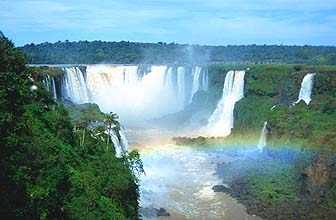 Lima, Peru at about 2:00 a.m., and ultimately arriving in Buenos Aries, Argentina, about 7:30 a.m. We then change airports, and fly to Iguassu Falls. The plan is to stay two nights there, fly back to Buenos Aires (and stay the night) on Saturday, and then board the Norwegian Crown by 6:00 p.m. The ship leaves Sunday night to cruise down the Argentine coast, over to the Falklands, around Cape Horn, through the Chilean Fiords, and ending up in Santiago, Chile on April 8, 2007; from whence we fly home. Patty then starts her new job as the International Intellectual Property Manager for Volcom. (Benefits include free use of the skateboarding park!!!)
Lima, Peru at about 2:00 a.m., and ultimately arriving in Buenos Aries, Argentina, about 7:30 a.m. We then change airports, and fly to Iguassu Falls. The plan is to stay two nights there, fly back to Buenos Aires (and stay the night) on Saturday, and then board the Norwegian Crown by 6:00 p.m. The ship leaves Sunday night to cruise down the Argentine coast, over to the Falklands, around Cape Horn, through the Chilean Fiords, and ending up in Santiago, Chile on April 8, 2007; from whence we fly home. Patty then starts her new job as the International Intellectual Property Manager for Volcom. (Benefits include free use of the skateboarding park!!!)
March 22, 2007 LAX to Buenos Aires to Puerto Iguassu Our flight out of LAX was uneventful. Hans picked us up at home about 10:30 a.m. and we left Denali and Jessie sitting on the front lawn, watching us go. (Jessie had a late start school day.) It only took us 45 minutes to get to LAX with no traffic and Hans dropped us off at the Bradley Terminal: always a cultural experience in and of itself. We checked in, x-rayed the bags, had lunch at the Daily Grill, and made our way through security to the gate. LAN, Aero Mexico, and some of the other smaller users get to bus their passengers to the far end of the airport where they board on a gate built in the middle of the airport. The good news was that the plane was a relatively new Boeing 767-300, with 2/3/2 seating in Coach class. We had a window and the aisle seat next to it, with plenty of leg room and overhead space. The plane was about 3/4 full, so things went smoothly. The aircraft had a state-of-the-art video/sound system, with 50 or so movies on demand, various audio channels, including full length albums. Patty and I both watched "The Queen," a great movie about the impact of Princess Diana's death on the British Royal Family. I then watched "Iwa Jima" and "Casino Royal." Patty watched something a little lighter. I finished up with listening to the entire Bruce Springsteen "Born in the USA" album with my Bose headphones. This is probably the best airplane entertainment system we have ever had on a flight. It made the 8 hours go by fast. They fed us twice and it was quite a pleasant flight.
Patty's cold is really kicking up and she is not a particularly happy traveler. She got some antibiotics just before we left, and with heavy doses of Advil Cold & Sinus, hopefully she will be better in a day or two.
Our connection in Lima was painless (other than being at 1:00 a.m.) and we were back on another Boeing 767-300. This time though, we slept as much of the four hour flight as we could. The sun was just peeking over the horizon as we made our descent into  Buenos Aires. The city sprawls over a large area just south of a large bay off the Atlantic Ocean. Montevideo, Uruguay is on the north side of the bay and Buenos Aires is on the south side. The bay reminds me of Galveston Bay outside of Houston. Since several slow moving rivers run into it, is is quite muddy and brown.
Buenos Aires. The city sprawls over a large area just south of a large bay off the Atlantic Ocean. Montevideo, Uruguay is on the north side of the bay and Buenos Aires is on the south side. The bay reminds me of Galveston Bay outside of Houston. Since several slow moving rivers run into it, is is quite muddy and brown.
The skyline has lots of modern high-rise buildings, but on close inspection there are a lot of European style high-rise apartment buildings, most of which are in need of a coat of paint. The city has a down at the heels European feel to it and looks a lot like southern Italy, without quite the graffiti problem. It is built on a flat plain, just above sea level and there are no hills or mountains in sight. The temperature was in the high 70's when we got out of the airport, and promised to get warmer.
We had researched transportation options before we left and found a bus service between the International Airport and the National Airport closer to downtown. We found it with no problem, and for $10 each, we got a seat on a very nice tour bus style bus. It was fun to wind around town and the ride took an hour and a half as we were stuck in traffic most of the way. There is a good freeway (actually toll road) into the city center from the International Airport, but to get to the other airport, we had to wind through downtown. It was actually fun to see the city and get a little feel for the street life. The people are much more European looking than in Mexico or Peru. The population seems to be much more Spanish and other European, and Indian looking people are somewhat rare, or so it seems in our first hours in the country. In Mexico and Peru, the Indian component of the population is much stronger.
The National Airport is right on the bay, northwest of downtown a mile or so. When we got out of the bus we were swarmed with big, voracious mosquitoes, and it was good that Patty could get to the repellant quickly.
We went in, checked in for our 12:25 p.m. flight to Iguassu Falls, and had an overpriced latte, yogurt and bread at an airport cafe. The airport is modern and the terminal is new and comfortable. 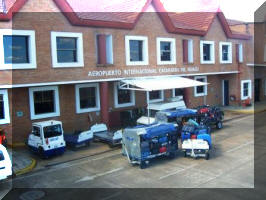 The flight to Iguassu got off uneventfully and our seats were right in the middle of a French tour group, mostly made up of 20 and 30 year old singles. They were a fun group and kept the hour flight lively. We got to the airport in Iguassu, a small, but clean and efficient place, and quickly got our bags and a taxi. Our driver spoke English and gave us a nice tour on the way to the hotel, about 20 km away from the airport.
The flight to Iguassu got off uneventfully and our seats were right in the middle of a French tour group, mostly made up of 20 and 30 year old singles. They were a fun group and kept the hour flight lively. We got to the airport in Iguassu, a small, but clean and efficient place, and quickly got our bags and a taxi. Our driver spoke English and gave us a nice tour on the way to the hotel, about 20 km away from the airport.
It is a subtropical forest environment, with lush forest and undergrowth. A big surprise just outside of the airport was that the forest had a lot of pine trees in it. They are a medium size with long needles, but beautiful trees. The air was thick with yellow butterflies and the warm tropical air just wrapped around you like a warm, fuzzy blanket. I quickly packed away the fleece I had been carrying on the airplane.
The Argentine portion of the falls area is on a long neck of Argentina that stretches northward between Brazil and Paraguay. Two rivers come together at the top of the neck and the rivers form the borders between the three countries. The town of Puerto Iguassu is at the northern edge of this neck of land. Between the airport and and the town is the National Park that is the Argentine portion of the falls. Since the river forms the country border, the western half of the falls is in Argentina and the eastern half is in Brazil. Paraguay sits on the top of the neck. We drove past the entrance to the park on the way to our hotel.
Our hotel, the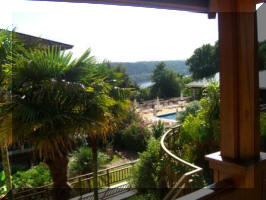 Hotel Esturion, is located at the northern edge of town, about 200 meters from the overlook where you can see the confluence of the two rivers and look across the rivers to Paraguay and Brazil. It is a nice hotel, with a tropical feel to it: wide open beam ceilings in the common areas, lush foliage, hardwood and tile floors everywhere. Our room is air-conditioned and has a great king size bed. After we checked in, we took a walk down the road to the confluence of the rivers and peered into Paraguay and Brazil. Their jungle looks about the same as the Argentine on the south and west side of the rivers.
Hotel Esturion, is located at the northern edge of town, about 200 meters from the overlook where you can see the confluence of the two rivers and look across the rivers to Paraguay and Brazil. It is a nice hotel, with a tropical feel to it: wide open beam ceilings in the common areas, lush foliage, hardwood and tile floors everywhere. Our room is air-conditioned and has a great king size bed. After we checked in, we took a walk down the road to the confluence of the rivers and peered into Paraguay and Brazil. Their jungle looks about the same as the Argentine on the south and west side of the rivers.
We walked back to the hotel, Patty went into the room to get some rest, and I walked on into town to a little market to buy some bottled water and a beer. (I just did not want to pay the mini-bar price of $16.00 pesos ($5.33 USD) for a bottle of Evian.) We showered and napped until 8:00 p.m. when the restaurant opened. We walked over and got seated immediately. Then all of the tour groups started wandering in, including the French tour group that had been on our airplane. This looks a little like Machu Picchu, where 95% of the tourists are on package tours. That is sort of unfortunate for the local tourism industry, in that it takes jobs away from the local taxi drivers, restaurants and smaller hotels. The tour groups use buses, stay and eat at the larger hotels and move the groups quickly through. The tourist pays more for the trip, but the tour company negotiates a reduced rate with the hotel, and a fat slice of the tourist dollar goes out of the local economy and into the tour organizer's pocket.
The dinner suffered from the tour group mentality. While you could order ala carte from the menu (which Patty did), they encouraged the use of the buffet, which was relatively mediocre, but a good way to feed the crush of the tour groups that all came in between 8:00 and 8:30 p.m. Patty's steak, while generous in size and very flavorful, was tough. The buffet, which I got talked into, was mostly less than mediocre. At least the whole dinner was cheap, 100 pesos ($33 USD), including a bottle of Argentinean wine.
We went back to the room and quickly to bed, as we had missed the last night's sleep on the airplanes.
March 23, 2007 Iguassu Falls We got up and got going about 8:30 a.m. with a passable breakfast at the hotel. We walked down the road to the three borders area where we had seen signs for the bus. Turns out that there are a number of bus routes, and we ended up on a local bus that wandered around town, taking kids to school, etc. We asked the driver and he told us to wait a few stops and dropped us off on the main road and told us to take the "Cataratas" (or "falls" bus). We waited about 25 minutes in a little bus shelter with an Indian woman and her baby who were also going to the Park (her to sell things from a blanket), and the bus came, and for 4 pesos each, we got the ride to the National Park. A better deal than the 80 pesos the taxi driver wanted.
The picture from the air was taken as we were leaving Iguassu, and shows the scope of the falls. They are not over a hundred feet high, but they go on for 2 km in a thousand distinct falls.
The National Park grounds are beautiful, with wide paved walkways and tasteful buildings. We were walking toward the narrow gauge railway that takes you from the visitor's center to the top of the falls, when we passed the booth selling a combination jungle tour and boat ride to the bottom of the falls. The taxi driver was pitching it yesterday, and for $30 USD each, we bit.
We walked a little further and then got into the elevated truck with nice plastic seats with about 20 other people. A guide who spoke both Spanish and English got on and our "jungle" tour started. She was very knowledgeable about the flora and fauna and we spent 30 minutes touring the jungle on a dirt road. The ride ended at a staircase down to the river.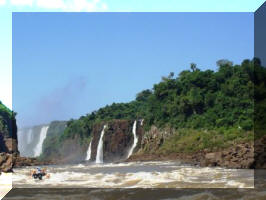 There we got on a large hard bottom inflatable, and were given a dry bag and instructions to take everything off we could, because we were going to get wet. We put shoes, purses and fanny packs in the bags, but kept our shirts and pants on. A lot of the guys took their shirt off, which ended up being a good idea, as we got as wet as if we had stood in a shower.
There we got on a large hard bottom inflatable, and were given a dry bag and instructions to take everything off we could, because we were going to get wet. We put shoes, purses and fanny packs in the bags, but kept our shirts and pants on. A lot of the guys took their shirt off, which ended up being a good idea, as we got as wet as if we had stood in a shower.
We went up the river zooming through some small rapids. The driver did a quick u-turn, and took us back to a little inlet where three tapir were swimming. One was actually on the bank and two were in the water doing hippopotamus imitations. The tapir are the largest rodents, and look just like a 60 lb. mouse. They are the size of a small pig but look just like a really big mouse.
After looking at them for a while, we zoomed up the river and played around the base of the falls.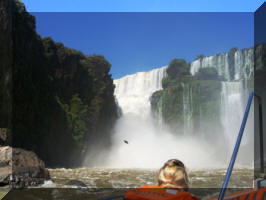 After getting a good look at the Argentinean side, we went around the corner for a look at the Brazilian falls. The falls are almost 2 km wide and are a hundred different water falls, all stretched out along a basalt cliff about 120 high. After we had a look at both sides, they told us to put our cameras away, and the boat proceeded to drive under as many of the falls as it could. It was like someone had turned a fire hose on us and we all got drenched. I had a T shirt and light weight shorts, while Patty had a lightweight top, but jeans on. They took us to a staircase and unloaded us near the base of the falls. We could then take a small boat over to an island in the river, with a swimming beach, but we declined and tried to dry out a little before we put on our shoes.
After getting a good look at the Argentinean side, we went around the corner for a look at the Brazilian falls. The falls are almost 2 km wide and are a hundred different water falls, all stretched out along a basalt cliff about 120 high. After we had a look at both sides, they told us to put our cameras away, and the boat proceeded to drive under as many of the falls as it could. It was like someone had turned a fire hose on us and we all got drenched. I had a T shirt and light weight shorts, while Patty had a lightweight top, but jeans on. They took us to a staircase and unloaded us near the base of the falls. We could then take a small boat over to an island in the river, with a swimming beach, but we declined and tried to dry out a little before we put on our shoes.
There is a system of excellent trails, many with perforated walkways over parts of the river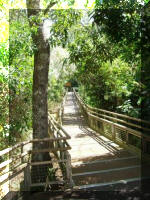 . The walkways go to many viewpoints and then climb up to the top of the falls and go along the top with many viewpoints from the top. We spent a couple of hours walking around. In the middle, we stopped at a cafe and had a cold drink and sandwich. Patty's cold was really sapping her energy, so we took it slow. There were millions of butterflies, including one with a perfect "88" design on each wing. A Cotati, a raccoon-like creature, visited us looking for lunch when we stopped for a break. The narrow gauge railway runs along the Argentina side of the falls, all the way to a walkway that goes to an overlook over the Brazil side of the falls. We rode the train there, but since it was out in the sun and several hundred yards long, we opted to stay on the train and ride back to the park headquarters. We sat across from a French vascular surgeon and his wife and talked to them all the way back. With his slow English and Patty's French, we had a great conversation on the way back, talking about kids, professions, medicine, Blackberries, etc. They were a nice couple about our age and we had a great time with them.
. The walkways go to many viewpoints and then climb up to the top of the falls and go along the top with many viewpoints from the top. We spent a couple of hours walking around. In the middle, we stopped at a cafe and had a cold drink and sandwich. Patty's cold was really sapping her energy, so we took it slow. There were millions of butterflies, including one with a perfect "88" design on each wing. A Cotati, a raccoon-like creature, visited us looking for lunch when we stopped for a break. The narrow gauge railway runs along the Argentina side of the falls, all the way to a walkway that goes to an overlook over the Brazil side of the falls. We rode the train there, but since it was out in the sun and several hundred yards long, we opted to stay on the train and ride back to the park headquarters. We sat across from a French vascular surgeon and his wife and talked to them all the way back. With his slow English and Patty's French, we had a great conversation on the way back, talking about kids, professions, medicine, Blackberries, etc. They were a nice couple about our age and we had a great time with them.
Back at the headquarters, we went into a Pizza place and Patty got a couple of slices of pizza and I a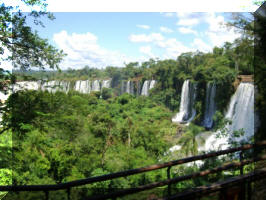 very large bottle of beer. We ate and cooled off before walking out of the gate to catch the bus. It was easier this time, as only one local bus goes out to the Parc Nationale. It was crowded and we had to stand until the first stop in town. It pulled into the bus station, and all but two people got off. We asked the bus driver if it went on to the Tres Fronteres area, and he said yes, and asked us where we were staying. We told him, and he dropped us off right in front of our hotel.
very large bottle of beer. We ate and cooled off before walking out of the gate to catch the bus. It was easier this time, as only one local bus goes out to the Parc Nationale. It was crowded and we had to stand until the first stop in town. It pulled into the bus station, and all but two people got off. We asked the bus driver if it went on to the Tres Fronteres area, and he said yes, and asked us where we were staying. We told him, and he dropped us off right in front of our hotel.
Patty was still feeling crummy, so she went to the room and I went down to the pool and took a quick swim to wash off the sweat, sunscreen and mosquito repellant. (No wonder the pool water was a little murky: I guess everyone else did the same thing.) We were going to go find another restaurant in town for dinner, but with Patty still not feeling well, looks like we will eat at the hotel again tonight--just avoiding the buffet.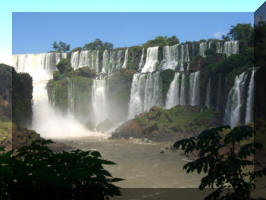
March 24, 2007 Iguassu to Buenos Aires We got up, had breakfast at the hotel, packed, and negotiated a moderately reasonable fare back to the airport with the hotel private taxi, and arrived by 8:30 a.m. for our 10:15 a.m. flight. We could have arrived 45 minutes before flight time, as the only people in the small airport were for our flight and everything was quick and easy. We met a young couple from Salt Lake City who had rented a car and toured the Northern Argentina mission area where he had been a missionary 11 years before and were on their way to Buenos Aires for a sales reward trip he won for selling skin care products. Apparently selling the Lord to the Lamanites was good preparation for selling skin creams.
On the flight, I sat next to a micro-biologist from the University of Minnesota who was a specialist in agricultural soil microbes. He was originally from Australia, had worked for 10 years in Colombia, learned Arabic to work on agricultural projects in the Egyptian deserts and was now at the University of Minnesota. He was on his way to Cordoba for a conference, but he and his wife had made the side trip to the falls. He had noticed me reading the Economist and commented on how difficult it was to get through it each week. We both like it because is is about the most unbiased source of news around.
We arrived at the Sol Melia TRYP (sounds like "trip") hotel in downtown Buenos Aires after a short and inexpensive taxi ride. The taxi stand line was longer than the ride. The hotel is a narrow building downtown, squeezed between other buildings on a narrow street. We were very impressed with the Sol Melia in Lima, so we booked this one. They are a Spanish chain and this one was just as nice as the Lima hotel. Modern, comfortable rooms, with flat screen TV's, internet connections, and very large bathrooms. Lots of marble and wood.
The hotel is just a half block off of a pedestrian street (Lavalle) that is full of shops, restaurants, theaters, etc. Two blocks up is the intersection of another pedestrian-only street, (Florida) that also runs for blocks with the same sort of environment. Florida ends at a square block mall that is the functional equivalent of Rodeo Drive for Argentina. There were guards at the doors to keep out the riff-raff, but we made it in anyway. The domed central area had frescos on the ceiling and the shops included all of the world's high end clothing merchandisers as well as a sprinkling of South American brands. 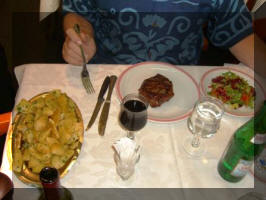 The only American shop was an outdoor themed Timberland.
The only American shop was an outdoor themed Timberland.
After walking all the way up to San Martin Square, and seeing the obelisk (right across the street from the fourth McDonald's we had seen, and the first Burger King), we walked back and made it back to the hotel for a nap. One of Patty's co-workers at Latham was from Buenos Aires and had given us a list of restaurants in Buenos Aires. Her favorite, El Palacio de la Papa Frita, (735 Lavalle) was about two blocks away from our hotel on Lavalle, so we walked up there about 8:00 p.m. for dinner. It was really spectacular. I had my first really good steak in Argentina (finally away from the tourist traps) and their specialty, "papas fritas," is a French fried potato. It is really different in that they take a thin potato slice, crimp the edges and fry it. They look like big, fat French fries, but are hollow inside. We had ours sprinkled with basil and garlic, as Angelica had recommended, and they were delicious.
It was really spectacular. I had my first really good steak in Argentina (finally away from the tourist traps) and their specialty, "papas fritas," is a French fried potato. It is really different in that they take a thin potato slice, crimp the edges and fry it. They look like big, fat French fries, but are hollow inside. We had ours sprinkled with basil and garlic, as Angelica had recommended, and they were delicious.
Lavalle Street was really fun at night, with all kinds of street performers, mimes, comedians (sort of lost on us non-Spanish speakers) and street musicians at various places on the street. There was a Michael Jackson look-a-like dancing to his tunes, a half dozen different costumed and made-up mimes on little platforms, performing for kids and their parents, a trick soccer player doing incredible things with the ball, and musicians trying to find a quiet corner where people could hear the violins. It was really a fun night out, with lots of families and kids running around. We were really lucky that our hotel was right off the action.
March 25, 2007 Buenos Aires We slept in and ate a late breakfast at the hotel. We may board the ship any time between 1:00 p.m. and 5:00 p.m. It looks like it will just be a dozen or so blocks from the hotel, so an easy taxi ride. We will probably check in early, in an attempt to "beat the crowd." I fried the voltage converter trying to get Patty's hair dryer to work in Puerto Iguassu, so the laptop is running low on battery. I am hoping the ship has 110 volt, or maybe we can find the fuse for the voltage converter in Montevideo, Uruguay tomorrow.
We walked around the city a little more after checking out of our hotel and putting our luggage with the bellman. We walked down the hill toward the port and the waterfront.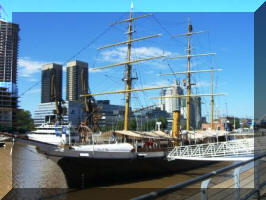 It was about 6 blocks down to a nice waterfront area with marinas, old ships and restaurants overlooking the marinas. We walked around for about an hour and then back up the hill to our hotel. There, we retrieved our luggage, got a cab and took a 15 minute ride down to the commercial docks, where the Norwegian Crown was hidden behind acres of stacks of containers. The ship was docked just forward of a container ship loading up. The checking-in procedures were fairly quick (especially since we had pre-registered with the ship and had our Argentina embarkation papers still from our entrance into the country). A bus ride through the container field took us to the ship, where we got on, got our ID cards and pictures taken, and found our stateroom. It is on the lowest passenger level, all the way aft on the starboard side, but does have two portholes with a view if you stand up. At least it lets light in, and for what we paid, we cannot complain.
It was about 6 blocks down to a nice waterfront area with marinas, old ships and restaurants overlooking the marinas. We walked around for about an hour and then back up the hill to our hotel. There, we retrieved our luggage, got a cab and took a 15 minute ride down to the commercial docks, where the Norwegian Crown was hidden behind acres of stacks of containers. The ship was docked just forward of a container ship loading up. The checking-in procedures were fairly quick (especially since we had pre-registered with the ship and had our Argentina embarkation papers still from our entrance into the country). A bus ride through the container field took us to the ship, where we got on, got our ID cards and pictures taken, and found our stateroom. It is on the lowest passenger level, all the way aft on the starboard side, but does have two portholes with a view if you stand up. At least it lets light in, and for what we paid, we cannot complain.
We had lunch in the buffet, and sat with two delightful ladies from Mesa, Arizona. They were about 80 and had left their husband/significant others back home and were on the trip by themselves. One was a retired PhD. in mathematics that taught college math during her career. Both were originally from Albany, New York. After lunch, we came back to our room, found our luggage in the hall and came in and put our stuff away. We then had the mandatory life boat drill, which got as much attention as the emergency landing speech on an airplane. I checked out the internet cafe; and with 110 power in the room and wireless internet connection on the 8th deck, we are up and running again. Hopefully, I can post this later this evening.
The ship left the dock at 6:00 p.m. and we got an unpleasant surprise with our cabin. It is located all the way aft on the starboard side, and the engine noise when we are at sea is comparable to being on our boat, which is not pleasant, with lots of vibration, and noise. It got a little better when they throttled back at sea, but we went to the front desk and asked for a change of cabin. They said that they would see what they could do - a pilot was leaving the ship after tomorrow and we might get his cabin.
Dinner was very good and we sat with a couple and their two 20-something sons from Idaho. They were all very nice and we had a good talk. I was able to order a bottle of wine and have it held for the next night, since I did not finish it all. We went to bed shortly after dinner, in our vibrating cabin.
March 26, 2007 Montevideo The ship docked in Montevideo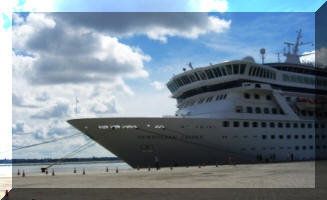 , Uruguay just about 7:00 a.m. I was up about 6:00 a.m. and peering out our portholes watching the port go by and watching the tugs dance with the ship. Quite entertaining, if one likes nautical things. Once the ship docked, our cabin became blissfully quiet.
, Uruguay just about 7:00 a.m. I was up about 6:00 a.m. and peering out our portholes watching the port go by and watching the tugs dance with the ship. Quite entertaining, if one likes nautical things. Once the ship docked, our cabin became blissfully quiet.
We took a fairly leisurely time in getting ready and left the ship after a quick breakfast about 9:30 a.m. We avoided the swarms of tour sellers, taxi touts and various vultures, and made our way down a painted walkway out of the port compound. We crossed the street and found one of the places listed in the Lonely Planet Guidebook as worthwhile, the Mercantile, which is an old warehouse converted to shops and restaurants. They were just getting going; building the wood fires in each stall and throwing on the meat to cook for lunch. We wandered out of there and up the street; found a Pharmacia and got Patty some more cold medicine (they even gave us change for a $20 bill in $1 USD because we had no Uruguayan currency and were loath to go to the ATM for the two or three hours we were going to be in Uruguay).
The streets are pleasant, and the town is built on a wide peninsula, with a shallow ridge going down the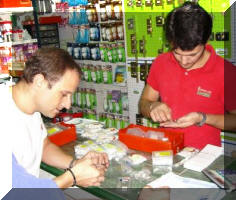 middle. The squares and parks are on the top of the ridge, with the streets running down the sides like the bones of a fish from the backbone (only straighter). The streets are cobble stone and the walkways stone blocks and everything looks like it has been around for a hundred and fifty years. The temperature was about 72 degrees and we later saw a mechanical thermometer on a building that went from 70 degrees to 78 degrees--no lower and no warmer. Nice to live in a climate where that is the range. Unfortunately, a lot of the buildings had window air conditioners on upper floors and the condensation just dripped onto the sidewalk. One learned to watch for puddles on the sidewalk and walk around those spots.
middle. The squares and parks are on the top of the ridge, with the streets running down the sides like the bones of a fish from the backbone (only straighter). The streets are cobble stone and the walkways stone blocks and everything looks like it has been around for a hundred and fifty years. The temperature was about 72 degrees and we later saw a mechanical thermometer on a building that went from 70 degrees to 78 degrees--no lower and no warmer. Nice to live in a climate where that is the range. Unfortunately, a lot of the buildings had window air conditioners on upper floors and the condensation just dripped onto the sidewalk. One learned to watch for puddles on the sidewalk and walk around those spots.
We also found a hardware store that had a 1" long, 2.5 amp fuse to replace the fried one in my voltage converter, so that is now back in business. That guy took a dollar bill and gave me change in Uruguayan currency. Patty wanted a highlighter and post-it notes for marking up the guidebook and we found those at two different stationary stores. We stopped for a Coke and a bakery and the nice girl behind the counter (who had worked on a Carnival Cruise ship in the Caribbean and spoke good English) got her helper to run down the street and change $4 USD for us so we could buy a Coke, a bottle of water and three croissants. She threw in an extra croissant just to be nice. They were just baked and were delicious.
Along the top of the hill, a pedestrian walkway connects the major squares and is a great shopping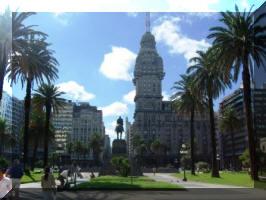 district. We sat on park benches and just people watched. One of the fun things was that at noon, lots of guys from restaurants, bearing silver trays with wrapped sandwiches on them, came bustling down the streets every which way, delivering lunches to offices. They all carried the food on silver trays and not in a bag. (We did see one young guy in a hurry put the sandwich in his hand and the tray under his arm as he crossed the street, but it went back on the tray as soon as he got close to his delivery.)
district. We sat on park benches and just people watched. One of the fun things was that at noon, lots of guys from restaurants, bearing silver trays with wrapped sandwiches on them, came bustling down the streets every which way, delivering lunches to offices. They all carried the food on silver trays and not in a bag. (We did see one young guy in a hurry put the sandwich in his hand and the tray under his arm as he crossed the street, but it went back on the tray as soon as he got close to his delivery.)
We walked back to the ship, had a late lunch, and sat around reading until the ship pulled away from the dock at 4:15 p.m. A rain shower came suddenly as we were pulling away from the dock, dousing the sunbathers at the pool. A few had enough to drink that they stayed in the rain and just opened another beer, but most came rushing back to the covered area.
We went by the reception desk to see if any other cabins were available and the receptionist told us that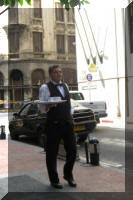 people usually complain about the vibration on the first leg of the trip in shallow water, but that it gets less as we get to the open sea. A woman on deck three (we thought we were on the lowest passenger deck-- I sure hope she paid less than us, but that does not seem possible) in the bow was complaining that the water noise in the bow was driving her nuts. They offered her no hope.
people usually complain about the vibration on the first leg of the trip in shallow water, but that it gets less as we get to the open sea. A woman on deck three (we thought we were on the lowest passenger deck-- I sure hope she paid less than us, but that does not seem possible) in the bow was complaining that the water noise in the bow was driving her nuts. They offered her no hope.
When we got back to the room, the vibration was noticeably less in deeper water, but the engine noise is certainly still there. However, coins no longer vibrate off the table.
Tomorrow we are at sea so it will be a nice rest day. The next day we go to Puerto Madryn, a Welsh community where penguins live. Perhaps not quite together, but we hope to go to a reserve on the Valdez Peninsula and see the colony. It is quite a way out, so it will be a challenge to find a tour that can take us there and get us back to the ship on time. We think we can beat the ship price of $165 per person though.
March 27, 2007 South Atlantic Sea Today was a day at sea to make the southing down the South American coast toward Puerto Madryn. Today, we slept in late, I finished one book and started another and we ate, napped, ate and read. It was nice to have a day to catch up on our rest though, as we have been pushing pretty hard. The weather remains nice; the sea conditions are mild and it is a good day to do nothing. After a half hour walk around in circles on the deck, we wandered in one of the bars and caught a trivia game which Patty played. That may be the highlight of the day.
There are lots of petrel like birds on the ocean, but we have not seen any other ships nor can we see land. The wind was kicking up about 15 knots this morning, but has calmed to less than 10 knots this afternoon. It is following, so moderates the apparent wind created by the ship moving forward about 20 knots. It turns out this is the last South American cruise for this ship with Norwegian, as it will go north and be delivered to its new buyer in the Bahamas later this spring.
I finished "One World," by Peter Singer, a philosophy professor at Princeton and one of my favorite modern day thinkers. He makes a cogent argument for the ethics of recognizing we are all human beings on this earth and all should be considered in ethical decisions--nationalism be dammed. I then started "Between a Rock and a Hard Place" by Aron Ralston, the guy who had to cut off his own arm with his knock-off Leatherman in a Utah slot canyon, when it was pinned by a boulder and he had to choose between death with a hand or life without. The guy is actually a pretty good writer, but it certainly has a gory aspect to it.
March 28, 2007 Puerto Madryn We pulled into the dock a little before schedule at 9:30 a.m. in Puerto Madryn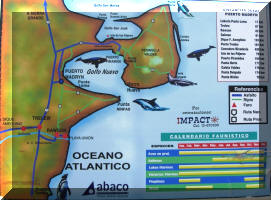 this morning. The town looks like something on the shore of Lake Mead, with the desert sloping down to a broad shallow beach. The ship dock is a couple of hundred yards long as the bottom slopes out very gradually and it is not deep enough closer in. The large bay is almost enclosed from the ocean, so there is no breakwater. The town has two reasons for existence, a bauxite mine and attendant ore ship loading facilities, and eco tourism because of the sea lion, elephant seals, penguins and whales in season (not counting the original farming done by the 19th century Welsh settlers -- the only sign of which is an occasional blond or redhead kid on the streets). The Welsh must have been crazy to think they could farm here because it is just sagebrush hills and looks a lot like Arizona or Southern Wyoming. There must be some fresh water somewhere, but we never saw it
this morning. The town looks like something on the shore of Lake Mead, with the desert sloping down to a broad shallow beach. The ship dock is a couple of hundred yards long as the bottom slopes out very gradually and it is not deep enough closer in. The large bay is almost enclosed from the ocean, so there is no breakwater. The town has two reasons for existence, a bauxite mine and attendant ore ship loading facilities, and eco tourism because of the sea lion, elephant seals, penguins and whales in season (not counting the original farming done by the 19th century Welsh settlers -- the only sign of which is an occasional blond or redhead kid on the streets). The Welsh must have been crazy to think they could farm here because it is just sagebrush hills and looks a lot like Arizona or Southern Wyoming. There must be some fresh water somewhere, but we never saw it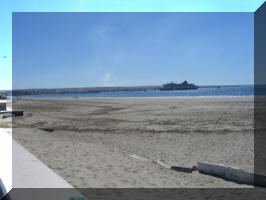 .
.
The town is fairly small, with a couple main streets. We tried to find the bicycle rental place listed in the guidebook, but the address was now a high rise apartment building. We asked around and found a beach place that rented dilapidated mountain bikes, kayaks, beach chairs, windsurfers, wet suits, etc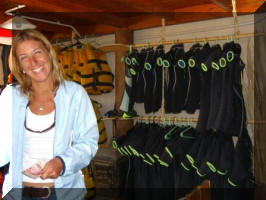 . We signed up for two bikes for $20 pesos each (about $6.25 USD), and rode south out of town about 3 km to a very nice "Ecological" study center. It is modern and is on a small hill overlooking the bay. They have exhibits involving most of the native Patagonian sea life. They gave us a 25 page booklet in English that explained the exhibits. The center was very well done and aimed primarily at school children, but provided a wealth of information for adults. It was very much like the Ocean Institute in Dana Point. A small college with a strong marine biology department is across the road
. We signed up for two bikes for $20 pesos each (about $6.25 USD), and rode south out of town about 3 km to a very nice "Ecological" study center. It is modern and is on a small hill overlooking the bay. They have exhibits involving most of the native Patagonian sea life. They gave us a 25 page booklet in English that explained the exhibits. The center was very well done and aimed primarily at school children, but provided a wealth of information for adults. It was very much like the Ocean Institute in Dana Point. A small college with a strong marine biology department is across the road .
.
We had lunch in their cafe and thoroughly enjoyed the experience. We rode the bikes back into town and around town for a while. On the ride back, we were treated to a site neither of us had ever seen before. A small beat-up sedan was coming the other way down the street, with a big furry dog standing on the roof of the car, facing forward with the wind in his face, giving an occasional bark just to let everyone know he was king of the road.
There were a lot of very nice houses along the beach road, on the inland side, with interesting architecture, looking new and well kept. Once we got into town, it looked like the nice places were high rise apartment buildings, with balconies and garages underneath. Things looked like security was an issue and maybe people were more comfortable in a secure building. However, just riding and walking around, the town seemed very safe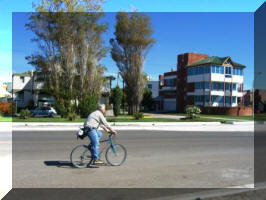 .
.
Patty decided to look for some running shoes, and the girl at the bike rental told us where to go, but everything closes between 2:00 p.m. and 4:30 p.m., so we went back to the ship and rested for a couple of hours, and then headed back out. She found some nice Reebok shoes in a very modern sporting goods store. We then went to a mountain shop, and I found a nice cap to keep the sun off my face. The town is full of outdoor shops because there are the Patagonian mountains to the west and lots of beaches and ocean activities up and down the coast. It is very remote and undeveloped, so people have to be pretty hearty to explore this area of South America.
After shopping for a while, we got back to the ship at 6:00 p.m., well in front of the 6:30 p.m. cut-off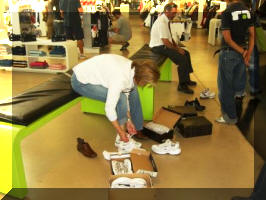 . We are off for the Maldives (or the Falklands as they are known by those Imperialists from the UK).
. We are off for the Maldives (or the Falklands as they are known by those Imperialists from the UK).
The food on the boat is very good as long as the buffet is avoided. The food there is mediocre, unless you go to the stations where they are serving something fresh.
We went up to the fancy Italian Restaurant (reservations only) on deck 11 to see if we could get a table, but were turned away. The hostess explained to us that not only could we not get in without reservations, that since we were both wearing jeans, we would not be let in even if we did have reservations. We had thought that the only dress code was long pants in the evening, but apparently slacks are required except in the buffet, even though they have not been enforcing that rule in the main dining room. We got reservations for Thursday at 7:00 p.m., so we will return properly dressed. We went back to the room, dressed appropriately, and went back up to the main dining room, where we were seated with a couple from Australia (who had run an Australian travel agency in Los Angeles for 10 years), a couple from Kansas, and a couple of ladies from Florida. The Australians were fun and interesting.
March 29, 2007 At Sea in the South Atlantic Today we are at sea going mostly south from South America to the Malvinas (know as the Falklands to the Imperialistas). Patty is off to the gym in her new shoes. I am about finished with my cut-off-your-own-arm book and ready to start another one. There is a full schedule of activities on the ship, with two sessions of bingo, a poker tournament, tap dancing and tango lessons and a pastry demonstration. Like I said, I am ready to start another book.
We did go to a lecture on Cape Horn and sailing ships and it was quite good. The lecturer was a British biologist and naval historian and had a very professional presentation. We had dinner at the "Pasta Cafe," an inspired name for one of the ship's reservation-only restaurants. This one does not charge extra, as does "Le Bistro," the French cafe. It was a good thing, because the food was not really special but the room is small and the service was good. We ran around and made reservations at the two other theme restaurants, the "Bistro" and the aptly named "Chop Sticks."
After dinner and running around making reservations at the other restaurants, we went to a magic show in the main theater. The magician was an Italian that spoke 5 languages, and was both a mediocre magician and comedian. However, given the price (free), it was OK.
March 30, 2007 The Falklands (or Malvinas) Godforsaken! All I have to say is that they must have had time-share salesmen in 19th century England to talk people into immigrating to this place. Windblown, bleak, cold, landmines, remote--it has it all.
The captain announced that given a strong tail wind and following seas, we would make it to Stanley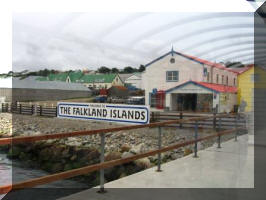 a couple of hours early, so we ordered room service breakfast for 7:00 a.m. and were ready to go by 8:00 a.m. when we saw the tenders circling the ship. We walked down to the deck to board a tender and discovered that crowd control was only letting tour groups off the ship. Because the ship was anchored out of the inner harbor, the tender ride was 25 minutes to the dock; a one hour round trip after unloading. We were told that we could go upstairs and get a tender ticket and wait until our number was called. We went upstairs and waited in a line for 20 minutes until they started handing out tender tickets. We got #47 and #48 and went back to our cabin until 9:00 a.m. We went back before they announced our number and got in line again. They finally let us into the first non-tour tender.
a couple of hours early, so we ordered room service breakfast for 7:00 a.m. and were ready to go by 8:00 a.m. when we saw the tenders circling the ship. We walked down to the deck to board a tender and discovered that crowd control was only letting tour groups off the ship. Because the ship was anchored out of the inner harbor, the tender ride was 25 minutes to the dock; a one hour round trip after unloading. We were told that we could go upstairs and get a tender ticket and wait until our number was called. We went upstairs and waited in a line for 20 minutes until they started handing out tender tickets. We got #47 and #48 and went back to our cabin until 9:00 a.m. We went back before they announced our number and got in line again. They finally let us into the first non-tour tender.
We went to the visitor center (pictured above) and got a map to a penguin nesting cove. It was a four mile walk or a $10 per person taxi ride. We opted for the taxi. A total of 3,000 people live in the Falklands, with 2,000 of them living in the "capital" of Stanley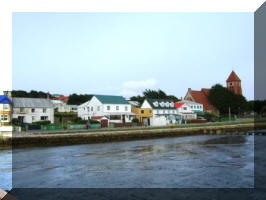 . The town has the look of an Indian Reservation that recently opened a casino. The guide book they gave us said that they have recently been selling fishing permits for the one commercial fishery they have, squid. Apparently between the sale of the fishing permits, a limited amount of tourism, and the infusion of military spending by the UK, (including 1,500 soldiers stationed on a base to protect the windswept rocks) the town has a lot of nice new houses. I wonder if the Brits have considered buying each of the 1,000 or so families a nice house in London, giving them a pension, and punting this rock to the Argentines. Seems like it would be a good deal -- Oh wait, they are exploring for oil off the north coast of the rock -- maybe they will hang on long enough to see if they find any.
. The town has the look of an Indian Reservation that recently opened a casino. The guide book they gave us said that they have recently been selling fishing permits for the one commercial fishery they have, squid. Apparently between the sale of the fishing permits, a limited amount of tourism, and the infusion of military spending by the UK, (including 1,500 soldiers stationed on a base to protect the windswept rocks) the town has a lot of nice new houses. I wonder if the Brits have considered buying each of the 1,000 or so families a nice house in London, giving them a pension, and punting this rock to the Argentines. Seems like it would be a good deal -- Oh wait, they are exploring for oil off the north coast of the rock -- maybe they will hang on long enough to see if they find any.
We took the "taxi," actually a 12 person van, with 8 Germans and us, out to the cove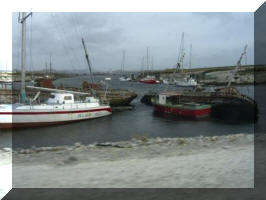 close to town where there are Magellanic Penguin nests. It was an interesting ride, past old shipwrecks and a yacht harbor that kind of looked like Katrina had visited. I had never seen boats tied up to wrecks before. But as the guidebook says, nothing goes to waste here in the Falklands, because everything has to be brought in by ship; even the rock is too hard to use as a building material. The half dozen yachts were all heavy duty beasts, with hard cabins and no nice canvas Biminis or dodgers. Given the weather we saw, you could understand the preference to sail from inside the boat.
close to town where there are Magellanic Penguin nests. It was an interesting ride, past old shipwrecks and a yacht harbor that kind of looked like Katrina had visited. I had never seen boats tied up to wrecks before. But as the guidebook says, nothing goes to waste here in the Falklands, because everything has to be brought in by ship; even the rock is too hard to use as a building material. The half dozen yachts were all heavy duty beasts, with hard cabins and no nice canvas Biminis or dodgers. Given the weather we saw, you could understand the preference to sail from inside the boat.
The rookery is actually above a beautiful white sand beach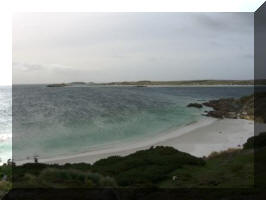 . It is nice to see such beautiful white sand, untracked by human foot -- it appears that the landmines the Argentine defenders left behind discourage romps on the beach, or maybe it is the 40 degree water. We wandered down the trail and spotted a lot of empty burrows, as most of the penguins have abandoned this place for the winter. They lay their eggs in November and by March, the chicks are mature enough that they all go to sea to eat and swim until the next southern hemisphere summer, when they will come back and lay more eggs and live in their burrows again. We did spot one late to leave penguin, and a little while later, we spotted a second. We have now seen penguins in the wild. We also saw a seal lying on the beach and some of our group spotted three dolphins in the cove, but we missed those. The temperature was in the low 50's and a 30 mph wind was blowing, so we were happy to go back and get in the van for the ride back to town.
. It is nice to see such beautiful white sand, untracked by human foot -- it appears that the landmines the Argentine defenders left behind discourage romps on the beach, or maybe it is the 40 degree water. We wandered down the trail and spotted a lot of empty burrows, as most of the penguins have abandoned this place for the winter. They lay their eggs in November and by March, the chicks are mature enough that they all go to sea to eat and swim until the next southern hemisphere summer, when they will come back and lay more eggs and live in their burrows again. We did spot one late to leave penguin, and a little while later, we spotted a second. We have now seen penguins in the wild. We also saw a seal lying on the beach and some of our group spotted three dolphins in the cove, but we missed those. The temperature was in the low 50's and a 30 mph wind was blowing, so we were happy to go back and get in the van for the ride back to town. 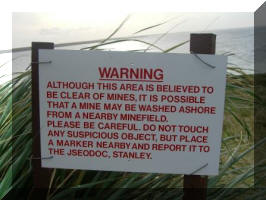
Terrible things, landmines. The Argentines put them on the beaches around Stanley in their aborted attempt to stop the British re-invasion in 1982, but they proved ineffective against Exocet missiles that the British could blow the World War II vintage Argentine warships out of the water with from over the horizon and helicopter landed troops. The Argentines had their bluff called and surrendered the Islands back to the British after a couple of months and a few Argentine ships going to the bottom with most of their crews. However, the landmines remain 25 years later. In Africa, Cambodia and other places around the world, the landmines remain long after the conflict is over and is part of the history books.
We walked around town a bit and went into what is reputedly the world's most expensive grocery store. It has a small food section in the middle and a very large liquor section on one side and an equally large video rental on the other side. The satellite TV dishes we saw are pointed almost horizontal to the north, and they might not get very good reception. With a new video rental in the player, a bottle of scotch in hand, and one of the 60,000 sheep cuddled up on the couch next to a guy, the winter here might not be so bad after all.
About 1:00 p.m., we headed back to the ship. We had our bags searched by Falkland's Customs on our way out (what the hell they were looking for, I have no idea) and caught a tender back to the boat. The wind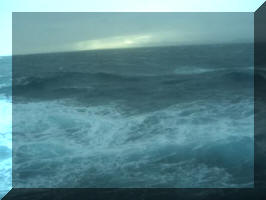 was gusting to 35 knots and the tender driver had to make two attempts to hit the ship platform dock. We had lunch in the dining room (avoiding the buffet at all costs) and went back to the room for a nap. About 3:00 p.m., we pulled up the anchor, as a British Warship was sensibly pulling in and picking up his mooring. They sent a half dozen guys out in a big inflatable and actually landed one of the guys on the mooring buoy to take the ship's lines. That was quite a sight and I hope they were wearing wet suits because they were getting very wet. The guy on the buoy definitely deserves an extra ration of grog.
was gusting to 35 knots and the tender driver had to make two attempts to hit the ship platform dock. We had lunch in the dining room (avoiding the buffet at all costs) and went back to the room for a nap. About 3:00 p.m., we pulled up the anchor, as a British Warship was sensibly pulling in and picking up his mooring. They sent a half dozen guys out in a big inflatable and actually landed one of the guys on the mooring buoy to take the ship's lines. That was quite a sight and I hope they were wearing wet suits because they were getting very wet. The guy on the buoy definitely deserves an extra ration of grog.
The captain announced that it was 435 nautical miles to Cape Horn and that we were expecting 35 to 40 knot winds and moderate to heavy seas. The picture here is taken out of our porthole window and we are still in the lee of the island. I definitely would not like to be out in this weather in my boat.
We have dinner reservations tonight at Le Bistro (paying the extra $15 per head to dine on escargot) at 7:00 p.m. I was up in the very forward part of the ship as we left the port, watching the ship maneuver around the rocks, and the movement was significant. Luckily, in our cabin low and aft, the motion seems quite sedate. It will be interesting tonight when we get out of the lee of the Islands and into the teeth of the gale.
Dinner at Le Bistro was good and we stopped at the internet cafe and burned some more $0.45 per minute internet time updating this web site, checking e-mail, etc. Luckily, the ship appears to have its own cell phone network that the Blackberry picks up. We get and respond to most e-mail on that and I was even able to listen to a voicemail message. We have avoided making any other calls though, as we do not know what kind of a god-awful rate they are going to charge the cell phone provider for this service, but I am sure it will not be cheap. I hope the data rates are not too steep. We can see regular e-mail, but have to go to the internet cafe and use the computer to download attachments, as faxes and ".pdf" files are unreadable on the Blackberry.
March 31, 2007 Cruising in the 50's Toward Cape Horn To sailors, the south latitudes in the 40's and 50's are known as treacherous waters. Storm systems circle the globe pretty much uninterrupted by land, as do the seas. Cape Horn reaches through the 40's and into the 50's, and the Antarctic Peninsula reaches north to within 600 miles of Cape Horn, compressing the weather systems between the only two spits of land on earth that reach into these latitudes. The weather and seas have not disappointed. Last night we had 30-40 knot winds and 15-30 foot seas. The ship rams its way into this maelstrom, and with a hesitation and shudder, pushes aside the water to rise over the next wave. A few seconds of near weightlessness is followed by another hesitation and shudder as the ship heads down the next trough and into the next wave. We seemed to move through the worst of it about 3:00 a.m., when walking to the bathroom to pee was like on our boat at sea in 6 to 8 foot seas. Later, the wind and waves moderated and after daybreak, we only hit a big rouge sea occasionally, causing the pause/shudder. The sky and sea are leaden and grey. Out our porthole, petrels dance and swoop through the wave tops, oblivious to the weather, looking for breakfast and perhaps using the ship as a little of a windbreak.
Our cabin turned out to be good for these conditions, because way at the back of the ship the vertical motion is not nearly as pronounced as at the bow. I am sure those prone to sea sickness are not having a good time, but Patty and I are fine and enjoyed sleeping in and reading.
We are scheduled to round Cape Horn at about 5:00 p.m. and then we will turn east and north, enter the Beagle Channel from the east and dock at Ushuaia tomorrow. There is supposed to be some great hiking right out of town and we may take advantage of that.
Later that day: The middle of the day was sunny and the wind and sea calmed down a little, with the wind probably no more than 20 knots. However, as we got further south, and out of the lee of the landmass, the wind and seas kept building. The captain announced later that due to the wind and sea conditions, the ship was only making 11 knots headway and that our Cape Horn ETA would be approximately 9:00 p.m. They nevertheless did their Cape Horn ceremony on the stern at 5:00 pm, where the captain and his first mate, dressed in Viking helmets with chin straps, pour a ladle of seawater over the heads of those dopes who are silly enough to believe that the Vikings had a Cape Horn ceremony. They did put a Viking helmet on the subject before the baptism, so not too much water got down the subject's neck.
At about sundown (6:30 p.m.), the wind and seas really kicked up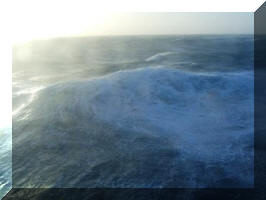 . We had dinner reservations at 7:00 p.m. in the Chinese restaurant (Chopsticks), and it was getting pretty wild by then. They had seasickness bags disbursed around the ship, outside of the elevators, etc. and there were lots of lone diners eating. The ship was lurching and heeling slightly and the waitress in the cafe had quite a dance getting around the tables, even pouring tea without spilling any. Patty and I were betting as to when the water in our glasses was actually going to slop over the top onto the table. We made it through dinner and ran around the ship looking for a good place to watch the action. I think the captain had decided that since the ship was already sold, he would see what the old girl could take.
. We had dinner reservations at 7:00 p.m. in the Chinese restaurant (Chopsticks), and it was getting pretty wild by then. They had seasickness bags disbursed around the ship, outside of the elevators, etc. and there were lots of lone diners eating. The ship was lurching and heeling slightly and the waitress in the cafe had quite a dance getting around the tables, even pouring tea without spilling any. Patty and I were betting as to when the water in our glasses was actually going to slop over the top onto the table. We made it through dinner and ran around the ship looking for a good place to watch the action. I think the captain had decided that since the ship was already sold, he would see what the old girl could take.
We finally found a spot in the 8th deck library, with floor to ceiling windows and overstuffed leather chairs. The staff turned the lights off and we sat there, watching the books on the shelves slam back and forth and waiting to see if the glass doors exploded. A woman just outside the door took an inadvertent seat in a large potted plant, but she came out the best of the struggle, with the plant looking worse for wear, but she unhurt. The sea was amazing. Our cabin is at least 30 feet above the waterline, and we had seas higher than our cabin windows-- and that was before dark when it really got bad. The spray was going higher than the library windows on the 8th deck, probably 80 feet above the water line. The sea was a mass of foam. The spindrift from the top of the waves was just blown flat and there was an occasional breaking wave, with tubes that would have made a surfer happy.
About 9:30 p.m. the Captain announced that the Cape Horn light was in sight and that we were turning in the lee of the island and running for the Beagle Passage. Since we were on the starboard side of the ship, and the turn was to the starboard, we ran up to the bar on the 11th deck and saw the light making its flash every 5 seconds. We were probably 5-10 miles off, but that was close enough under those conditions. Patty and I went to bed and woke up to find the ship tied to the dock in Ushuaia. They announced that the peak wind speeds were 112 knots and radio communication with the lighthouse indicated those were the highest winds recorded in 7 years. I sure never want to see wind and seas like that in my own boat. The seas never really got as big as those winds could build them, so the wind must have been fairly localized. Nevertheless, the maelstrom we saw was scary enough.
April 1, 2007 Ushuaia 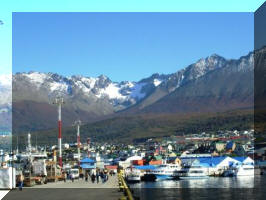 We woke up to the sound of the room service warning telephone call, we bolted out of bed and I only got my T-shirt on before there was a knock at the door. Patty had her pants on, so I jumped in the bathroom, while she opened the door. We were tied to the dock and there was no wind and not a cloud in the sky. Given that we were not too many miles north of Cape Horn, it seemed a pretty amazing transformation. Since the ship was leaving at 1:30 p.m., and we wanted to go the Parque Nationale, and do some hiking, we hustled around getting dressed, saving showering for when we got back. We walked to the end of the pier and the taxi cabs there wanted $100 for a three hour tour of the park. We passed and walked up into town
We woke up to the sound of the room service warning telephone call, we bolted out of bed and I only got my T-shirt on before there was a knock at the door. Patty had her pants on, so I jumped in the bathroom, while she opened the door. We were tied to the dock and there was no wind and not a cloud in the sky. Given that we were not too many miles north of Cape Horn, it seemed a pretty amazing transformation. Since the ship was leaving at 1:30 p.m., and we wanted to go the Parque Nationale, and do some hiking, we hustled around getting dressed, saving showering for when we got back. We walked to the end of the pier and the taxi cabs there wanted $100 for a three hour tour of the park. We passed and walked up into town 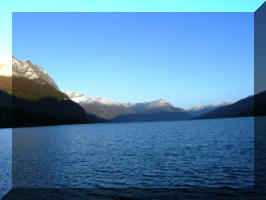 and flagged down another taxi. We thought he offered to take us to the park for 50 pesos, so we agreed. We drove out of town, onto a dirt road, and through some really beautiful country with dense forests and rushing rivers. The entrance to the park is about 20 km out of town and we were charged 20 pesos each to get in. It became apparent that our driver was giving us a tour and with a 45 minute drive to the trail we were thinking of hiking, we needed to arrange for him to come pick us up as we would have a hard time getting back to town if he just left us there. We went ahead with the tour; the actual area for visitors to the park being fairly small and covered by roads. We first went up to a beautiful mountain lake, with snowcapped peaks looming over it. Next we went down by the Beagle Channel and hiked around a bay
and flagged down another taxi. We thought he offered to take us to the park for 50 pesos, so we agreed. We drove out of town, onto a dirt road, and through some really beautiful country with dense forests and rushing rivers. The entrance to the park is about 20 km out of town and we were charged 20 pesos each to get in. It became apparent that our driver was giving us a tour and with a 45 minute drive to the trail we were thinking of hiking, we needed to arrange for him to come pick us up as we would have a hard time getting back to town if he just left us there. We went ahead with the tour; the actual area for visitors to the park being fairly small and covered by roads. We first went up to a beautiful mountain lake, with snowcapped peaks looming over it. Next we went down by the Beagle Channel and hiked around a bay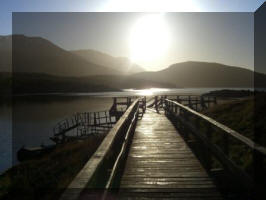 , making the first footprints on the frost covered wooden walkways. Then we went to the main bay, and hiked along the shore. The trail we were going to take, ended at the bay and we were disappointed that we did not have time to hike the whole 5 mile trail.
, making the first footprints on the frost covered wooden walkways. Then we went to the main bay, and hiked along the shore. The trail we were going to take, ended at the bay and we were disappointed that we did not have time to hike the whole 5 mile trail.
After hiking around the bay, and going out to the shed sized "post office at the end of the world" on a pier (if you don't count the Chilean settlement of Puerto Williams across the channel, which is further south than the Argentine "end of the world" at the end of the highway at this bay. Argentine Highway 3 ends there, 3,000 km south of Buenos Aires and 17,000 km south of Alaska (according to the sign.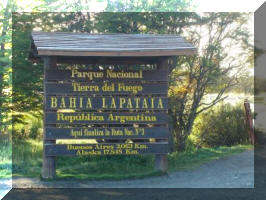 )
)
We saw rabbits, hawks, other birds and ducks which we could not identify and had a good morning. It would be a great place to be if you had the time to spend hiking around and if the tour buses full of tourists were not clogging the trails. Unfortunately, it kind of felt like Yosemite Valley on a summer weekend by the time we got in our taxi and headed back to town. Fortunately, we had beaten most of the tour buses and had the first bay all to ourselves.
We discovered that our communication with the driver was way off and he was expecting 200 pesos for the tour, and we thought he wanted 50. We paid him with the last of our Argentine money and $35 USD. The total was about $70, or $35 per person, so we beat the ship price of $65 per person for the same thing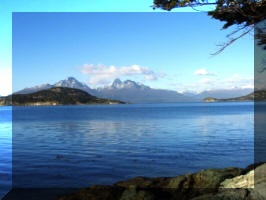 .
.
After getting back into town, we hiked up the hill to the residential areas and walked around meeting all of the local dogs, most of which were chained up. Every house had a dog, mostly big ones. We even saw a beautiful St. Bernard and a couple of laid back Golden Retrievers. A German Sheppard or two made us glad they were chained up. We walked though town as well. Being Sunday morning, the only thing open were the souvenir shops and a few restaurants getting their bar-b-ques ready. At noon we walked back to the ship for lunch, having worked up a good appetite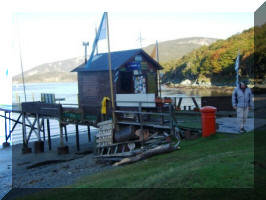 . We were blessed by good weather, with sun and mid-fifty degree temperatures.
. We were blessed by good weather, with sun and mid-fifty degree temperatures.
This afternoon we cruise the Beagle Channel and look at scenery, wildlife and glaciers, on our way to Punta Arenas, our first Chilean port of call.
There were a small collection of cruising boats in Ushuaia, the most we had seen this trip. They are really hardy looking boats, again most with hard dodgers or pilot houses. These boats look like they are ready for serious wind. We also saw a fair number with unpainted aluminum hulls; a concession to the conditions. None had outside canvas dodgers or biminis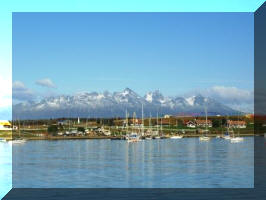 .
.
We pulled out of Ushuaia about 2:00 p.m. and cruised past dozens of glaciers on the north side of the Beagle Channel. Passing 5 major glaciers: the Holandia, Francia, Italia, Alemania, and Romanche glaciers, the good speaker on the trip narrated and did a good presentation on glaciers generally and these five in particular. This is really a wild and remote place. The whole afternoon we were in the channel, we only saw one other boat, a private sailboat motoring up the channel past us.
Patty and I scored great leather armchairs in the 11th floor bar to watch the cruise by the glaciers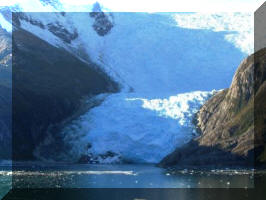 , sipping drinks (one margarita and one Coke). The only problem was that you had to either go outside to take pictures and take them over the heads of a half dozen people crowded by the rail or take them through the salt stained windows that still show the salt spray of the last couple of days. The scenery is really spectacular though
, sipping drinks (one margarita and one Coke). The only problem was that you had to either go outside to take pictures and take them over the heads of a half dozen people crowded by the rail or take them through the salt stained windows that still show the salt spray of the last couple of days. The scenery is really spectacular though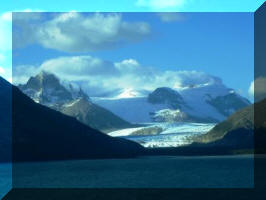 .
.
After the glacier show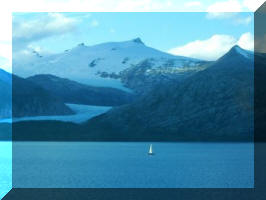 , Patty and I went to dinner and ended up sitting with the family from Idaho with the two 20-something boys. We then went to play trivia (tying for second- and not winning the prize: luggage tags). We then went to our second entertainment show. It was a Swiss comedian/magician who was really weak. The main qualification is that they have to do their shows in English/German/Spanish; cutting down on the number of possible performers. The "randomly selected audience member" was the same shill who the Italian magician had used a couple of nights before, so it was less than convincing that the guy's watch/wallet/tie/shirt could be taken from him "without him noticing." Maybe it would have been funny if we had been drinking heavily.
, Patty and I went to dinner and ended up sitting with the family from Idaho with the two 20-something boys. We then went to play trivia (tying for second- and not winning the prize: luggage tags). We then went to our second entertainment show. It was a Swiss comedian/magician who was really weak. The main qualification is that they have to do their shows in English/German/Spanish; cutting down on the number of possible performers. The "randomly selected audience member" was the same shill who the Italian magician had used a couple of nights before, so it was less than convincing that the guy's watch/wallet/tie/shirt could be taken from him "without him noticing." Maybe it would have been funny if we had been drinking heavily.
April 2, 2007 Punta Arenas, Chile We woke up tied to the dock in Punta Arenas, Chile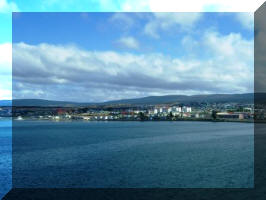 . The wind was howling and it was 48 degrees outside. We took our time getting up and having breakfast and were off the ship at 9:00 a.m. We dutifully carried our Chilean Agriculture Declaration form, which was delivered yesterday afternoon to our cabin, but no one asked to see it or looked to see if we were really sneaking an apple off the ship. The town is about a 100,000 people, and has some manufacturing and supports the surrounding sheep farms, fishing boats and shipping. As there were coal mines in the hills above town, and it is located in a big bend in the Straights of Magellan, connecting the Atlantic and the Pacific, it was an important shipping port before the Panama Canal, and still is the most important commercial center for the southern part of the continent. That being said, it is a pretty ugly town, with mostly low corrugated iron buildings interspersed by a mansion or two built by those who controlled the mining and shipping interests.
. The wind was howling and it was 48 degrees outside. We took our time getting up and having breakfast and were off the ship at 9:00 a.m. We dutifully carried our Chilean Agriculture Declaration form, which was delivered yesterday afternoon to our cabin, but no one asked to see it or looked to see if we were really sneaking an apple off the ship. The town is about a 100,000 people, and has some manufacturing and supports the surrounding sheep farms, fishing boats and shipping. As there were coal mines in the hills above town, and it is located in a big bend in the Straights of Magellan, connecting the Atlantic and the Pacific, it was an important shipping port before the Panama Canal, and still is the most important commercial center for the southern part of the continent. That being said, it is a pretty ugly town, with mostly low corrugated iron buildings interspersed by a mansion or two built by those who controlled the mining and shipping interests.
Monday morning, and there was a line at each bank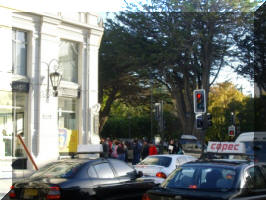 we passed, presumably with people trying to deposit or cash their first of the month checks. It almost looked like a bank panic, but we realized it was the first banking day of the month and that probably explained the lines and crowds. We went into a bank's ATM alcove (you actually have to use your ATM card to open the locked door to get into the alcove) and put my card into a machine. If offered three choices and the middle one was $10,000 pesos. We were not sure of the exchange rate, and not wanting to get too much Chilean currency, we chose the middle choice and took the one $10,000 bill that came out of the machine. We walked across the street into the town square and found a tourist information office. They told us the exchange rate was 535 to 1, so the $10,000 peso note was actually worth about $18 USD. Since the Chilean currency is a pretty stable currency, that was surprising.
we passed, presumably with people trying to deposit or cash their first of the month checks. It almost looked like a bank panic, but we realized it was the first banking day of the month and that probably explained the lines and crowds. We went into a bank's ATM alcove (you actually have to use your ATM card to open the locked door to get into the alcove) and put my card into a machine. If offered three choices and the middle one was $10,000 pesos. We were not sure of the exchange rate, and not wanting to get too much Chilean currency, we chose the middle choice and took the one $10,000 bill that came out of the machine. We walked across the street into the town square and found a tourist information office. They told us the exchange rate was 535 to 1, so the $10,000 peso note was actually worth about $18 USD. Since the Chilean currency is a pretty stable currency, that was surprising.
The town is interesting because it is full of shops for the outdoor enthusiast, including a North Face shop, a Marmot shop, aTimberland store, and numerous other shops selling mountain gear. However, this is the town you fly into if you are going to Torres del Paine National Park. That is where Fitz Roy and the other peaks are that are on the "Patagonia" clothing company logo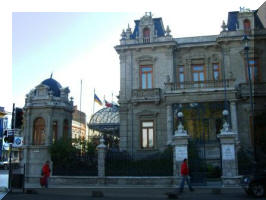 . It is a place I would really like to see, but the ship excursion there is by chartered flight only and costs about $1,000 per head (A hundred bucks less than we paid each for the entire cruise). We passed on that. You can rent a car and drive from here, but it is about 360 km north of here, at least 120 km of which is on a gravel road. If everything went right, you could possibly rent a car and drive four hours north, jump out of the car and take a picture (if the notoriously bad weather wasn't obscuring the peaks), get back in the car, drive another four hours south, and make the ship's 6:00 p.m. sailing. We elected not to do that, but I now have on my list to come back and spend at least a week there. Part of the problem with traveling, is that the more you see, the more you realize that you are just scratching the surface and how much more you are missing. That is exacerbated on a cruise ship, where the port stays are generally way too short.
. It is a place I would really like to see, but the ship excursion there is by chartered flight only and costs about $1,000 per head (A hundred bucks less than we paid each for the entire cruise). We passed on that. You can rent a car and drive from here, but it is about 360 km north of here, at least 120 km of which is on a gravel road. If everything went right, you could possibly rent a car and drive four hours north, jump out of the car and take a picture (if the notoriously bad weather wasn't obscuring the peaks), get back in the car, drive another four hours south, and make the ship's 6:00 p.m. sailing. We elected not to do that, but I now have on my list to come back and spend at least a week there. Part of the problem with traveling, is that the more you see, the more you realize that you are just scratching the surface and how much more you are missing. That is exacerbated on a cruise ship, where the port stays are generally way too short.
Patty bought me a topographical map of the Torres del Paine national park trekking routes and a black T-shirt that says "Trekking Torres del Paine-Chile" on the front, and that will have to do this trip. We went into a big grocery store where they had a gently sloping escalator to the second floor that you could take your shopping cart on. A new discovery for me. They had appliances and the refrigerators were about 2/3 the size of ours, as were the stoves. They sold DVD players and 15" TV sets made by Phillips. From the looks of things, their houses are smaller than we are used to. We went into a hardware store that had everything from carpet to paint to some great wood-burning stoves: just the thing for your backwoods Patagonian cabin.
We came back to the ship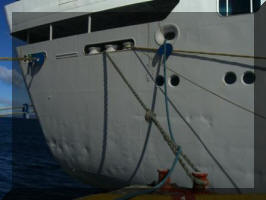 for lunch and saw some beautiful black and white dolphins playing in the bay around the boat. All our time at sea, and we saw our first dolphins while tied to a dock. We spend the next two days cruising the Chilean Fjords. Since the ship was docked on the starboard side this time, we were able to walk down the dock and get a picture of our cabin from the outside. Those two portholes with the water hose in front of them are our cabin. It is the last one aft, on the fourth deck. Most of the cabins on our deck have picture windows and that would be nice for the next couple of days, but we can see out if we peer out the porthole, and for what we paid for the cruise, we can go up to the public areas if we want to sit in a chair and look out a large window.
for lunch and saw some beautiful black and white dolphins playing in the bay around the boat. All our time at sea, and we saw our first dolphins while tied to a dock. We spend the next two days cruising the Chilean Fjords. Since the ship was docked on the starboard side this time, we were able to walk down the dock and get a picture of our cabin from the outside. Those two portholes with the water hose in front of them are our cabin. It is the last one aft, on the fourth deck. Most of the cabins on our deck have picture windows and that would be nice for the next couple of days, but we can see out if we peer out the porthole, and for what we paid for the cruise, we can go up to the public areas if we want to sit in a chair and look out a large window.
We went to dinner and sat at a large table with people from the US Virgin Islands, Australia, and Florida. As usual, we like the Aussies best. They are really down to earth and unpretentious-- something that could not be said of the others.
April 3, 2007 Cruising the Chilean Channels We slept in, which was not hard as it is cloudy, windy and rainy outside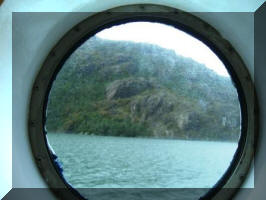 . The water is flat because we are in the channels between rocky islands with low, scrubby vegetation. Patty went to the gym and I went to breakfast. I sat with an interesting woman who had sailed around the world on a 76 foot aluminum yacht between 1998 and 2000 in Jimmy Cornell's Millennium Rally. She and her husband now live in Reno and have a small sailboat on Lake Tahoe. She had great stories. Patty and I met at 10:00 a.m. in the theater and heard another lecture by our biologist/navel historian, Melvin Foster. He is a great speaker and talked about Captain Cook's first voyage. I knew all of the stories from my reading, but he made a great presentation and it is great to hear the stories while we are in this environment. Patty had breakfast and I updated the web site, sitting across the table from her. I will go upstairs and upload it while she showers.
. The water is flat because we are in the channels between rocky islands with low, scrubby vegetation. Patty went to the gym and I went to breakfast. I sat with an interesting woman who had sailed around the world on a 76 foot aluminum yacht between 1998 and 2000 in Jimmy Cornell's Millennium Rally. She and her husband now live in Reno and have a small sailboat on Lake Tahoe. She had great stories. Patty and I met at 10:00 a.m. in the theater and heard another lecture by our biologist/navel historian, Melvin Foster. He is a great speaker and talked about Captain Cook's first voyage. I knew all of the stories from my reading, but he made a great presentation and it is great to hear the stories while we are in this environment. Patty had breakfast and I updated the web site, sitting across the table from her. I will go upstairs and upload it while she showers.
We read, napped and hung around the boat. I finished Ed Viesturs' "No Shortcuts to the Top;" his account of his climbing all 14 of the 8000 meter peaks, all of which are located in the Himalayan and Karakoram range, north of India and Pakistan, respectively. He relates his part in the 1996 rescue of the climbers coming down from the 1996 Everest disaster along with his role in filming the IMAX movie. It was especially fun because since he had been a guide with Rainier Mountaineering, a lot of the people mentioned in the book were people I had met or climbed with on Rainier and Denali.
We got to cruise by another glacier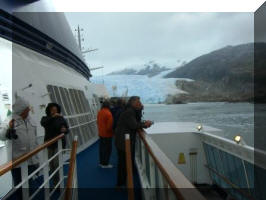 this afternoon, and the ship put down a boat to get a chunk of glacial ice
this afternoon, and the ship put down a boat to get a chunk of glacial ice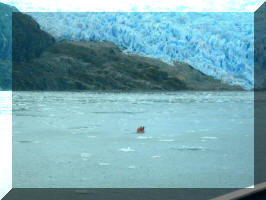 . The spa then offered a "hot stone and glacial ice massage," reputed to be a once in a life time experience for only $150. Amazing that no one else has thought of this and flown in glacial ice. I am sure it will be the next craze.
. The spa then offered a "hot stone and glacial ice massage," reputed to be a once in a life time experience for only $150. Amazing that no one else has thought of this and flown in glacial ice. I am sure it will be the next craze.
We went to a dance show, the evening entertainment, put on by a couple who taught Tango lessons on the boat and had previously danced in (no mention of placing) ballroom dance competitions. It seems that I have been totally spoiled by the Woodbridge High School talent shows, so it is hard to enjoy these shows.
Just about bed time, we came out of the channels and into to the open ocean. There were 12-15 foot long ocean swells, so we got rocked to sleep.
April 4, 2007 Cruising the Chilean Coast The ship is in the open ocean today, cruising north  up the coast, far enough off shore we cannot see land. it is windy, with 15-20 knot winds coming out of the north west. The skies are overcast and there are occasional rain showers. They are chipping paint on the deck above our cabin with a mechanical chisel and the cabin sounds like we are in a shipping container that someone is dragging a chain across. The big news of the day is that I finally spotted an albatross while I was walking on the deck to try to ameliorate the effects of the Eggs Benedict with salmon and spinach I had for breakfast. Patty went to the gym, but the albatross did not visit there.
up the coast, far enough off shore we cannot see land. it is windy, with 15-20 knot winds coming out of the north west. The skies are overcast and there are occasional rain showers. They are chipping paint on the deck above our cabin with a mechanical chisel and the cabin sounds like we are in a shipping container that someone is dragging a chain across. The big news of the day is that I finally spotted an albatross while I was walking on the deck to try to ameliorate the effects of the Eggs Benedict with salmon and spinach I had for breakfast. Patty went to the gym, but the albatross did not visit there.
We get our passports back from the ship this morning and this afternoon Melvin Foster is lecturing on Captain Bligh. He is always good. In the meantime, we are watching CNN and getting to see the Iranian President pardon the British troops and give each of them a T-shirt saying, "My uncle visited Iran and all I got was this lousy T-Shirt."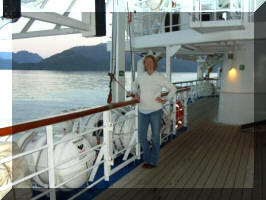
We went to the chocolate desert orgy hosted by the boat at 3:00 p.m. and gorged on chocolate cakes, cookies, brownies, mouse, ice cream, etc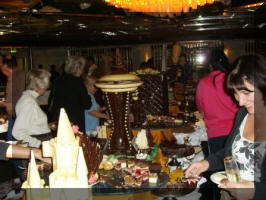 .
.
In the early afternoon we came into channels out of the open sea, passing down fairly narrow channels past rock, brushy islands. Strikingly, there is almost no sign of any human activity in these channels. There is also no obvious sea life except for some birds. We did pass one salmon farm, but no boats, fishing camps or any other activity. The shoreline is steep, rocky and the shore is covered with brush and a few scraggly trees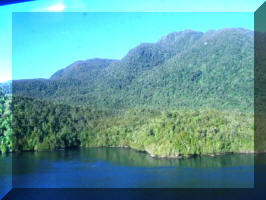 . There is little sign of fresh water and no flat land, so it looks like no one has made any use of these areas.
. There is little sign of fresh water and no flat land, so it looks like no one has made any use of these areas.
About 10:00 p.m., we pulled up to the dock in Puerto Chacabuco, and tied up to a very short dock. The bow and stern lines are tied to stations on the shore which are far forward and astern of the dock, which is only about 150 foot long. It was a clear, windless night, with a full moon, so we went out on deck and watched the docking and looked at the strange southern sky. Not a constellation or star in sight that we recognized.
April 5, 2007 Puerto Chacabuco, Chile This port is nothing other than a dock and a few houses and a hotel at the end of the road. The original port is about 6 or 8 miles up the road, but the channel has silted up so that ships can no longer go to the head of the channel. There is a habitable valley with a river running down it at the head of the channel and there is some agriculture and a lot of logging inland. We are planning on getting off the boat and just walking around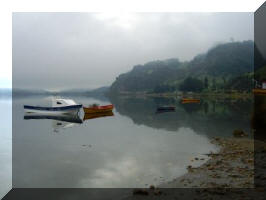 . The only thing that is at all commercial is a private nature part about 5 km away, which charges $35 USD per person admission. I think we will pass on that one.
. The only thing that is at all commercial is a private nature part about 5 km away, which charges $35 USD per person admission. I think we will pass on that one.
We walked all around the town, and up the road out of town a ways. They bay curves around in back of town and a river runs down the valley into town. The scenery is fabulous and it looks a lot like the Oregon or Washington Coast. My favorite part of the walk was when we stumbled on a housing tract , where they were building little houses about 20 by 25 foot, or about 500 square foot houses. Each house had two bedrooms in the back, one a little larger than the second; a tiny bathroom, a little kitchen and a living area. They were concrete foundations, wood framed and sided and roofed with corrugated steel that they painted after the building was finished. They were wired for electricity and each family appeared to install a wood stove themselves as all the installations were different. It was fun to see how they built very basic houses at a cost that had to be fairly minimal
, where they were building little houses about 20 by 25 foot, or about 500 square foot houses. Each house had two bedrooms in the back, one a little larger than the second; a tiny bathroom, a little kitchen and a living area. They were concrete foundations, wood framed and sided and roofed with corrugated steel that they painted after the building was finished. They were wired for electricity and each family appeared to install a wood stove themselves as all the installations were different. It was fun to see how they built very basic houses at a cost that had to be fairly minimal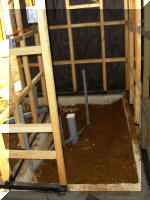 .
.
We walked for about two and a half hours and finally went back to the ship for lunch. The ship was leaving at 1:30 p.m., so we did not have time to do much else. It was too bad that someone did not have some kayaks to rent, because it would have been a marvelous bay to kayak in.
After lunch and a short nap, we went to another maritime lecture by Melvin Foster, and learned about the Atlantic passenger ship trade as it developed from sailing vessels to steamships. He will lecture about 20th Century ships on Saturday, our last day at sea .
.
Tomorrow, we stop in Puerto Montt, Chile, the major port in the south of the country, and about 120,000 people. We have not figured out what we are doing there yet, but we will have to study the guide book and see what there is to do. We may even rent a car and see the surrounding countryside, or take one of the ship side touts up on their offer of a tour. Cab drivers were offering a tour of the surrounding area today for only $100.00 USD. I think if they sold any at that price, they had a pretty good day.
We are philosophically opposed to buying any of the ship tours because they are (1) overpriced, and (2) additionally remove you from the local culture. It is hard enough to get any feel for the local culture when we are sleeping on the ship, eating almost all of our meals on the ship, and traveling on the ship. It has been hard to actually arrange anything off of the ship in these tiny ports, because the distances are great to the parks, our shore stays are short, and our poor command of Spanish makes communication with the cab drivers or bus drivers difficult. There is little if any tourist infrastructure in these places other than that which is created by the ship. Nevertheless, we have had a good time and just wandering around the towns has been fascinating.
I started reading Jared Diamond's "Collapse" and it should be a great book about what causes cultures to fail and collapse entirely. He is a UCLA geography professor and a great writer.
April 6, 2007 Puerto Montt, Chile Today we docked at 7:00 a.m. in this city of about 120,000 people. We had agreed to meet our Idaho friends, Steve and Carrie Nielson and their sons, Bryan and Rick at 8:00 a.m. while we were eating dinner last night. They have a similar travel philosophy to us and are always looking to do fun things on the cheap. Rick was a missionary in Guatemala, and has good Spanish, so that is a bonus. We ordered room service breakfast and were on the gangway at 8:00 a.m. The weather report said 70% chance of rain, so we had our fleeces and shells.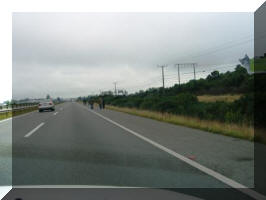
Steve and Carrie were waiting for us when we got off, but the boys had gone on ahead to scout out a car rental. Unfortunately, due to a map reading error, they went the wrong way. Outside the port gate, after we made our way through the taxi touts, we spotted them a block down the street coming back. We all walked the 2 km to the city center along the water front looking for the independent and the Hertz car rental agencies listed in the Lonely Planet guide book. We passed several, but most things were closed as this was Good Friday, and Chile is a very Catholic country, and it is a big holiday.
We finally found a Budget car rental, but they had no cars. We were standing around a gas station parking lot and we asked the proprietor where other car rental places were. He told us several, but also pulled a card out of his wallet and called a friend who rented cars. I talked to him on the phone; he had good English and offered to rent us two cars for $50 each. We accepted and he showed up about a half hour later. The gas station guy brought out chairs for us to sit in and let us use his bathroom.
Jorge Bauer showed up with one car and drove Steve, Bryan and I back to the other one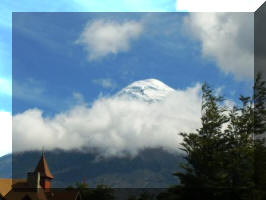 . Jorge is German, and moved to Chile as a child as his father took a job at the German school in Puerto Montt. He has a fish export business, a restaurant, and rents cars. He put us in older but serviceable little Nissans with a minimum of paperwork and let me pay him when we got back after I found an ATM machine.
. Jorge is German, and moved to Chile as a child as his father took a job at the German school in Puerto Montt. He has a fish export business, a restaurant, and rents cars. He put us in older but serviceable little Nissans with a minimum of paperwork and let me pay him when we got back after I found an ATM machine.
We split up and drove north on the Pan American Highway, a nice four lane, divided toll road. Puerto Montt is about the end of the Pan American Highway. It does continue across a ferry, onto an island that forms the western side of the big bay that Puerto Montt, and goes a few kilometers further south on the island, but Puerto Montt is the end for all practical purposes. Beyond here, it is all ferries until you get to the far southern islands, where there are some more roads. To go overland from here, you need to cross over the Andes to the east and into Argentina.
We got off the toll road at Puerto Varas, about 20 km north. 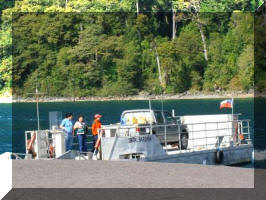 We had not stopped at an ATM machine yet, but were able to scrape enough Chilean money to pay the 400 peso toll. Along the toll way, there was a steady stream of people walking along the road, and they all got off at Puerto Veras. We stopped in Puerto Veras as well and found one ATM machine that was out of order, and then one that worked. We got 40,000 pesos, or a little less than $80 USD. Puerto Varas is a very outdoorsy town, with lots of people in outdoor gear and lots of outdoor shops. It also has a very German flavor, as does the whole area. It was more like being in a slightly run down Tyrolean town than in South America. The town sits on the western shore of Lago Llanquihue, the third largest lake in South America. It is about 30 by 40 km. Over the lake looms the Volcano Osomo, a 2652 meter (or about 8,000 foot) perfect cone volcano that is crowned with glaciers and has a ski resort on the north western flank. There is a beautiful river that runs down between it and another volcano to the south, the Rio Petrohue. The area looks like Oregon and is covered with lush forests.
We had not stopped at an ATM machine yet, but were able to scrape enough Chilean money to pay the 400 peso toll. Along the toll way, there was a steady stream of people walking along the road, and they all got off at Puerto Veras. We stopped in Puerto Veras as well and found one ATM machine that was out of order, and then one that worked. We got 40,000 pesos, or a little less than $80 USD. Puerto Varas is a very outdoorsy town, with lots of people in outdoor gear and lots of outdoor shops. It also has a very German flavor, as does the whole area. It was more like being in a slightly run down Tyrolean town than in South America. The town sits on the western shore of Lago Llanquihue, the third largest lake in South America. It is about 30 by 40 km. Over the lake looms the Volcano Osomo, a 2652 meter (or about 8,000 foot) perfect cone volcano that is crowned with glaciers and has a ski resort on the north western flank. There is a beautiful river that runs down between it and another volcano to the south, the Rio Petrohue. The area looks like Oregon and is covered with lush forests.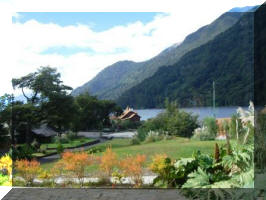 Lots of people were out picking berries from the wild bushes all around and selling them on the roadsides. There is a lot of mountain biking, kayaking, river rafting, climbing (we saw rock climbers on the walls of a road cut), fishing and boating. The south shore of the lake is lined with picturesque farms that are giving way to housing and hotels. There are a lot of beautiful houses on the shore that could have just as easily been in Lake Tahoe. (We even passed a small development on the lake shore named "California Homes.")
Lots of people were out picking berries from the wild bushes all around and selling them on the roadsides. There is a lot of mountain biking, kayaking, river rafting, climbing (we saw rock climbers on the walls of a road cut), fishing and boating. The south shore of the lake is lined with picturesque farms that are giving way to housing and hotels. There are a lot of beautiful houses on the shore that could have just as easily been in Lake Tahoe. (We even passed a small development on the lake shore named "California Homes.")
After getting our money and walking around the Puerto Varas a little bit (we later found out that everyone was gathering for an Easter parade) we drove along the south shore toward La Ensenada, a little town on the south east shore, just down from the ski resort. We turned up the Rio Petrohue to a point called Petrohue, which is south east of the volcano. The paved road ends just after you enter the Parque National Vicente Perez Rosales, and where a hotel is located on the bank of the river. About 6 more kilometers on a dirt road, you get to the end of the road at Petrohue, which is on the shore of Lago Todos Los Santos, a beautiful mountain lake that runs east and west between the volcanoes. A small one car ferry can take you the length of the lake, which gets you to another road, which a few kilometers later goes over Paso de Perez Rosales, which is the Argentine border.
We stopped at Petrohue and took pictures and looked at the beautiful hotel there. We say the Nielsons and another couple from the ship there. We also had a ship tour bus roll up and we left as they rolled up. The volcano had been playing peek-a-boo with us; hiding in the clouds as we drove around the lake, but she finally dropped her veil while we were at Petrohue and we got some good pictures.
We drove back to La Ensenada and spotted a road-side stand that sold fast food . We stopped, and got some French fries (Frites); sopapillas (fried bread with salsa), and drinks. They sold hot dogs, but we passed until we saw someone stop and get one. The were served in a big French roll, on a bed of chopped tomatoes, and covered with guacamole. You could then add your own mayonnaise, mustard or ketchup. I had to have one and it was delicious.
. We stopped, and got some French fries (Frites); sopapillas (fried bread with salsa), and drinks. They sold hot dogs, but we passed until we saw someone stop and get one. The were served in a big French roll, on a bed of chopped tomatoes, and covered with guacamole. You could then add your own mayonnaise, mustard or ketchup. I had to have one and it was delicious.
We then drove back through Puerto Varas, to the highway, and then north again another 10 kilometers to a town called Frutillary. The guidebook called it a quaint little German town, but there was really not much to see there. It had started raining, so the views over the lake toward the volcano were not there and that was probably its biggest charm. We got back on the toll road and drove south into Puerto Montt, gassed up the car and drove down to the port where we met the guy who rented us the car. Steve, Carrie and the boys got there a few minutes before we did. All together, the day cost us just short of the 40,000 pesos, or a little less than the $80 USD. 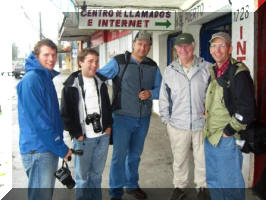
We ran back to a grocery store with the Nielson boys and Patty spent the rest of the cash on chocolate for the sea day tomorrow on the ship. We were close to the last ones on the ship at the 4:30 p.m. cutoff, but missed it by a few people. A black Labrador like dog tried to board with us, standing patiently in line up the gangway with everyone else, but got booted just before the top. I think he would have enjoyed the buffet.
We had dinner with a couple from Boston. He is a retired from making aircraft engines for General Electric. She presents seminars on the ship on handwriting analysis. She gets the cruise for free and he goes for half price. She does a 45 minute seminar every other day. They were very engaging and it was a fun dinner. After dinner we went to the evening show, which was a dance presentation. Since we are in the open sea, with the ship moving up and down a noticeable amount, especially in the bow where the showroom is located, it was fun watching a dance performance with a moving stage. That adds an other element to the dance that I doubt the dancers had to deal with in other venues.
After the show, the ship's navigation officer did a star seminar on the 11th deck. Since the ship's lights were on, and we had about a three quarter moon, about all he pointed out was the Southern Cross, which was interesting.
April 7, 2007 Cruising North up the Chilean Coast Other than a couple of lectures today, it should be a pretty relaxing day. The seas are calm except for a long ocean swell and the sky is clear. It should be warming up as we go north, so it should be a nice day at sea.
We went to the handwriting lady's lecture and the last Melvin Foster lecture on 20th century ocean liners. We took and nap and prepared for tomorrow. We have a ship tour since we have to leave the ship at 7:30 a.m. and our flight is at 8:05 p.m. Further, Valparaiso is an hour and a half drive from Santiago, and we were going to have to pay a cab or take buses between the two cities. We could have paid the ship $55 each for just bus transportation, but we elected to pop the big bucks and pay for a full day tour; getting the little badges stuck to our chests and everything.
We fly from Santiago to Lima and have an hour and fifty minute layover, and then get a direct flight to LAX form Lima, arriving at LAX at 7:30 a.m. We have to have our baggage outside our cabin door before mid-night tonight, so we have to pick our clothes and decide what shower supplies we want to carry with us as our baggage will be gone before we get up and shower.
This should be the last post before we get home.
April 19, 2007 Home We made it home after an exhausting overnight flight from Santiago, Chile. Hans and Jessie picked us up and I even went into the office for a few hours on Monday afternoon. After a week and a half, Patty having started her new job, and my desk dug out, life is back to normal. We are in the final troughs of Jessie deciding on what college to attend and we are off to Chicago for Patty's trademark association meetings the last weekend in April. The boat is still afloat, the dog alive, and the house still standing. We are ready to go again!!!